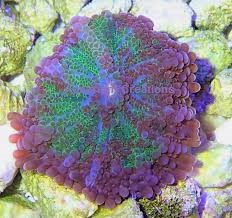The ORA Purple/Green Ricordea Yuma Mushroom Coral is highly desirable for both their vibrant color and attractive textures. Ricordea Yuma mushrooms are both beautiful and easy to care for. The Purple and Green Ricordea Yuma glow with strokes of neon green and dark purple. Somewhere between a mushroom and an anemone, Ricordea can actually be fed small amounts of food like frozen mysis shrimp. Simply place the food pieces on the disc and watch as it slowly travels towards the mouth at the center.
Pacific Ricordea Yuma Mushrooms are also called Pacific Flower Mushrooms, are found only in the Indo-Pacific zones, on the sea floor in relatively shallow, tropical or subtropical ocean environments. Distinctive features include a large mouth disk that takes up most of the organism, and brightly colored tentacles. Ricordea yuma have a large oral disk, covered in tentacles that spread out from the center in a spiral formation. The oral disk connects ventrally to a thin body, with a foot disk at its end. Like most Corallimorpharia, Ricordea yuma are very colorful. Ricordea Yuma will grow in size from less than a quarter of an inch up to approximately 3 inches in diameter.
Care Level
Pacific yuma can be sensitive and challenging so we do not recommend them for the beginner
Water Flow and Lighting
Pacific Yuma require a low to moderate water movement, and for their health they must be placed in an area that will keep the lighting at a low level. Otherwise they will not do well over the long term. Lighting can be Power compacts, T5's, LED's or even Metal Halides. All lighting can grow Ricordea Yuma Mushrooms as long as the proper level of light is provided. If a Par meter is available the appropriate lighting level is anywhere from a Par 80 to a Par 150. Which means they need to be placed in an area where they are shaded or kept from receiving direct light. If after a few weeks your Yuma are reaching toward the light, move them slightly toward the light. Do not change there position very much. After another few weeks see if they are good or reaching. Keep working with your Ricordea Yuma till they are in the perfect position. For lighting spectrum use between a 14-20K color spectrum for your bulbs for best coloration.
Placement
All mushrooms are semi-aggressive and require adequate space between themselves and other corals. If after a few weeks your Yuma are reaching toward your light, move them slightly towards the light. Do not change there position more than one or two inches. After another few weeks see if they are good or reaching. Keep working with your Ricordea Yuma till they are in the perfect position. For lighting spectrum use between a 14-20K color spectrum for your bulbs for best coloration.
Diet and Feeding
Mushroom corals receive the majority of their nutritional requirements through the process of photosynthesis, which simply means their lighting creates symbiotic algae called zooxanthellae in the body of the coral which provides its nutrition. We do recommend providing supplemental food such as micro-plankton or foods designed for filter-feeding invertebrates.
|



